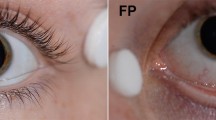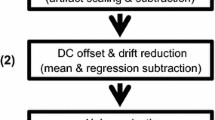Abstract
This study considers the precision and accuracy of bipolar corneal electrodes compared with unipolar intravitreal methods in collecting electroretinographic (ERG) recordings from a small animal. Flash ERGs were obtained from 9 adult guinea pigs on three occasions. Corneal bipolar (Burian-Allen) electrodes were used to collect data on the first two occasions whereas unipolar intravitreal electrodes were used on the last. We identified the a-wave, b-wave, oscillatory potentials, PIII and PII responses. Intensity-response functions were fit using a Naka-Rushton relationship with a bootstrap estimating the 95% confidence limits. Discrepancy analysis was applied to determine the coefficient of agreement. We found significantly larger amplitudes with unipolar intravitreal electrodes (ANOVA; a-wave, p<0.002; b-wave, p<0.001; Oscillatory potentials (OPs), p<0.005) especially at high intensities. Implicit times showed little differences between electrodes for the a-wave, significantly faster (p<0.03) b-waves at some intensities, and significantly slower (p<0.005) OP implicit times across all intensities. The PIII amplitude (log μV), sensitivity and timing were not significantly different (p>0.05) if expressed in logarithmic units but PII amplitude (log μV) was significantly smaller with corneal electrodes. We suggest that a conversion factor (x1.35) should be applied to data collected with bipolar corneal electrodes to estimate the amplitudes of the modelled parameters accurately. The corneal electrode gave a precision of ± 39 μV which yields a statistical power of 0.90 for a sample size of 7 subjects. We conclude that bipolar corneal electrodes provide smaller electroretinogram amplitudes due to their location and reduced span of the retinal generators.
Similar content being viewed by others
References
Birch DG, Fish GE. Rod ERGs in retinitis pigmentosa and cone-rod degeneration. Invest Ophthalmol Vis Sci 1987; 28: 140–150.
Breton ME, Quinn GE, Keene SS, Dahmen JC, Brucker AJ. Electroretinogram parameters at presentation as predictors of rubeosis in central retinal vein occlusion. Ophthalmology 1989; 96: 1343–1352.
Fulton AB, Hansen RM, Findl O. The development of the rod photoresponse from dark-adapted rats. Invest Ophthalmol Vis Sci 1995; 36: 1038–1045.
Gorfinkel J, Lachapelle P, Molotchnikokk S. Maturation of the electroretinogram of the neonatal rabbit. Doc Ophthalmol 1988; 69: 237–245.
Weisinger HS, Vingrys AJ, Sinclair AJ. The effect of docosahexaenoic acid on the electroretinogram of the guinea pig. Lipids 1996; 31: 65–70.
Cringle SJ, Alder VA, Brown MJ, Yu DY. Effect of scleral recording location on ERG amplitude. Curr Eye Res 1986; 5: 959–965.
Cringle SJ, Alder VA. An explanation of the 'Supernormal' b-wave in vitro. Invest Ophthalmol Vis Sci 1988; 29: 1044–1049.
Hennessy MP, Vaegan. Amplitude scaling relationships of Burian-Allen, gold foil and Dawson, Trick and Litzkow electrodes. Doc Ophthalmol 1995; 89: 235–248.
Gjotterberg M. Electrodes for electroretinography. Arch Ophthalmol 1986; 104: 569–570.
Esakowitz L, Kriss A, Shawkat F. A comparison of flash electroretinograms recorded from Burian Allen, Jet, C-Glide, gold foil, DLT and skin electrodes. Eye 1993; 7: 169–171.
Hood DC, Birch DG. A quantitative measure of the electrical activity of human rod photoreceptors using electroretinography. Visual Neurosci 1990; 5: 379–387.
Hood DC, Birch DG. The a-wave of the human ERG and rod receptor function. Invest Ophthalmol Vis Sci 1990; 31: 2070–2081.
Breton ME, Schueller AW. Analysis of a-wave maximum velocity in terms of cGMP cascade. Invest Ophthalmol Vis Sci 1992; 33: 1407.
Jacobs GH, Deegan JFI. Spectral sensitivity, photopigments, and color vision in the guinea pig (Cavia porcellus). Behavioural Neurosci 1994; 108: 993–1004.
Ebrey TG, Honig B. New wavelength dependent visual pigment nomograms. Vision Res 1977; 17: 147–151.
Shannon E, Skozenski AM, Banks MS. Retinal illuminance and contrast sensitivity in human infants. Vision Res 1996; 36: 67–76.
Wyszecki G, Stiles WS, Color science.2nd. New York: Wiley and Sons, 1982.
Nygaard RW, Frumkes TE. Calibration of the retinal illumination provided by Maxwellian view. Vision Res 1982; 22: 433–434.
Smith G, Atchison _DA. The eye and visual optical instruments. Melbourne: Cambridge University Press, 1997.
Sandberg MA, Hokyung L, Matthews GP, Gaudio AR. Relationship of oscillatory potential amplitude to a-wave slope over a range of flash luminances in normal subjects. Invest Ophthalmol Vis Sci 1991; 32: 1508–1516.
Lyons RG, Understanding digital signal processing. Boston: Addison-Wesley, 1997.
Naka K, Rushton WAH. S-potential from luminosity units in the retina of the fish (cyprinidont). J Physiol 1966; 185: 587–599.
Fulton AB, Rushton WAH. The human rod ERG: Correlation with psychological responses in light and dark adaptation. Vision Res 1978; 18: 793–800.
Peachey NS, Alexander KR, Fishman GA. The luminance-response function of the dark-adapted human electroretinogram. Invest Ophthalmol Vis Sci 1989; 29: 263–270.
Evens LE, Peachy NS, Marchese AL. Comparison of three methods of estimating the parameters of the Naka-Rushton equation. Doc Ophthalmol 1993; 84: 19–30.
Severns ML, Johnson MA. The care and fitting of Naka-Rushton functions to electroretinogram intensity-response data. Doc Ophthalmol 1993; 85: 135–150.
Granit R. Components of the retinal action potential in mammals and their relations to the discharge in the optic nerve. J Physiol 1933; 77: 207–238.
Anastasi M, Brai M, Lauricella M, Geracitano R. Methodological aspects of the application of the Naka-Rushton equation to clinical electroretinogram. Ophthalmic Res 1993; 25: 145–156.
Effron B, Gong G. A leisurely look at the bootstrap, the jackknife, and cross-validation. Amer Statistician 1983; 37: 36–48.
Foster DH, Bischof WF. Bootstrap variance estimators for the parameters of small-sample sensory-performance functions. Biol Cybernet 1987; 57: 341–347.
Maloney LT. Confidence intervals for the parameters of psychometric functions. Percept Psychophys 1990; 47: 127–134.
Keppel G, Design and analysis: a researchers handbook. New-Jersey: Prentice-Hall, 1982.
Ferguson GA, Takane Y, Statistical analysis in psychology and education. 6th edition. Singapore: McGraw-Hill, 1989.
Bland JM, Altman DG. Statistical methods for assessing agreement between two methods of clinical measurement. Lancet 1986; 307–310.
Shaw DE, Jones HS, Moseley MJ. Analysis of method-comparison data. Ophthal Physiol Opt 1994; 14: 92–96.
Birch DG, Anderson JL. Standardised full-field electroretinography normal values and their variation with age. Arch Ophthalmol 1992; 110:1571–1576.
van Lith GHM. Adaptives Verhalten und Spektralsensitivitat der elektrischen Antwort der Meerxchweinchennetzhaut. Vision Res 1966; 6: 163–170.
Leat WMF, Curtis R, Millichamp NJ, Cox RW. Retinal function in rats and guinea pigs reared on diets low in essential fatty acids and supplemented with linoleic or linolenic acids. Ann Nutr Metab 1986; Feb 8: 30: 166–174.
Ikeda H, Ripps H. The electroretinogram of a cone-monochromat. Arch Ophthalmol 1966; 75: 513–517.
Duke-Elder S. The vision of vertebrates. In, The eye in evolution. London: Kimpton, 1958; 602–619.
Hamano K, Kiyama H, Emson PC, Manabe R, Nakauchi M, Tohyama M. Localisation of two calcium binding proteins, Calbindin (28kD) and Parvalbumin (12kD) in the vertebrate retina. J Comp Neurol 1990; 302: 417–424.
Wali N, Leguire LE. Dark-adapted luminance-response functions with skin and corneal electrodes. Doc Ophthalmol 1991; 76: 367–375.
Author information
Authors and Affiliations
Rights and permissions
About this article
Cite this article
Weisinger, H.S., Sinclair, A.J. & Vingrys, A.J. Comparison of guinea pig electroretinograms measured with bipolar corneal and unipolar intravitreal electrodes. Doc Ophthalmol 95, 15–34 (1998). https://doi.org/10.1023/A:1001780529354
Issue Date:
DOI: https://doi.org/10.1023/A:1001780529354




